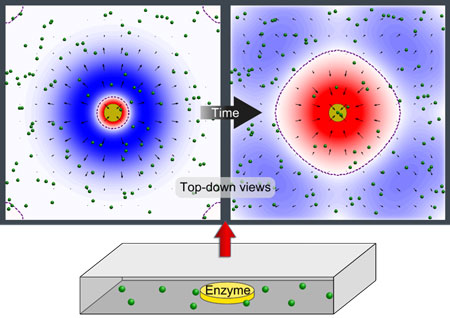| Posted: Feb 25, 2016 |
New trigger for self-powered mechanical movement
(Nanowerk News) A new way to use the chemical reactions of certain enzymes to trigger self-powered mechanical movement has been developed by a team of researchers at Penn State University and the University of Pittsburgh. A paper describing the team's research, titled "Convective flow reversal in self-powered enzyme micropumps," is published this week in the journal Proceedings of the National Academy of Sciences ("Convective flow reversal in self-powered enzyme micropumps").
|
 |
| This image illustrates pumping in two directions at once with an enzyme patch. A patch of enzymes immobilized on a surface acts as a fluid pump. The fluid, and the small particles (green spheres) carried by the fluid, can simultaneously be pumped away from the patch (blue) in some parts of the chamber and toward the patch (red) in other locations. This behavior changes over time and is due to the changes in fluid density that the reaction produces. (Image: University of Pittsburgh)
|
|
"These pumps provide precise control over flow rate without the aid of an external power source and are capable of turning on in response to specific chemicals in solution," said Ayusman Sen, Distinguished Professor of Chemistry at Penn State. "They also can remain viable and capable of turning on even after prolonged storage." Sen and Penn State Graduate Student Isamar Ortiz did the research team's experiments, which reveal that "simple reactions triggered by enzymes can be used to combine sensing and fluid pumping into single non-mechanical, self-powered, nano/microscale pumps that precisely control flow rate, and that turn on in response to specific stimuli," said Sen, who also made the initial discovery of enzyme pumps.
|
|
Potential uses of the self-powered enzyme micropumps include detecting substances, moving particles to build small structures, and delivering medications. "One potential use is the release of insulin to a diabetes patient from a reservoir at a rate proportional to the concentration of glucose in the person's blood," Sen said. "Another example is an enzyme pump that is triggered by nerve toxins to release an antidote agent to decontaminate and treat an exposed person. Also, because enzyme pumps can pump particles suspended in a fluid, it also should be possible to use them to assemble or disassemble small structures in specific locations by directional pumping."
|
|
Anna C. Balazs, Distinguished Professor of Chemical and Petroleum Engineering at Pitt's Swanson School of Engineering, who developed the team's computational modeling for this research with post-doctoral associate Henry Shum, said "Small-scale chemical synthesis and analysis commonly occur in fluid-filled chambers and require monitoring and intervention. Ideally, you would prefer that the process be as autonomous as possible."
|
|
Shum explained, "The chemical reaction causes a change in the density of the fluid, leading to a fluid flow. It creates a chemo-mechanical transduction, which is a beautiful example of chemical energy creating mechanical action, much in the same way that the human body converts chemical energy from food into movement." Shum examined the factors that cause variations in density in the enzymatic reactions and developed a mathematical model that enabled him to map a parameter range where the fluid could move in different directions at different times.
|
|
Ortiz's experiments at Penn State with the urease enzyme agree with the simulations at Pitt. Unlike other enzymes, which always pumped fluid in the same direction, the urease enzyme generated an unexpected flow pattern, with the direction of flow changing over space and time. The resulting chemical reaction network is analogous to an electrical system in a computer. Since each enzyme will behave differently, a multistage chemical reaction could be "programmed" into an experiment, with each step generating flow as determined by the action of a specific enzyme. "Much like Disney's "The Sorcerer's Apprentice," where you could snap your fingers and have mops and brooms clean your room for you, it's a scientist's wish to create systems which behave autonomously and controllably," Balazs said.
|
|
Even more complex behavior could be built up using different enzymes placed at different locations to create a dynamic cascade of events. Ortiz said, "The self-powered enzyme pumps could be used as self-regulated, stimuli-responsive, active, delivery vehicles."
|

